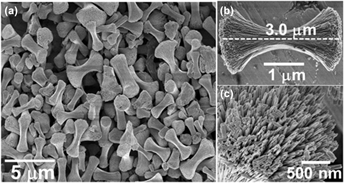Crossref Citations
This article has been cited by the following publications. This list is generated based on data provided by
Crossref.
Pal, Mou
Mathews, Nini R.
and
Mathew, Xavier
2017.
Surfactant-mediated self-assembly of Sb2S3 nanorods during hydrothermal synthesis – CORRIGENDUM.
Journal of Materials Research,
Vol. 32,
Issue. 3,
p.
697.
Diliegros-Godines, C. J.
Santos Cruz, J.
Mathews, N. R.
and
Pal, Mou
2018.
Effect of Ag doping on structural, optical and electrical properties of antimony sulfide thin films.
Journal of Materials Science,
Vol. 53,
Issue. 16,
p.
11562.
Molaei, Pezhman
and
Kazeminezhad, Iraj
2018.
Extended photocurrent performance of antimony trisulfide/reduced graphene oxide composite prepared via a facile hot-injection route.
Ceramics International,
Vol. 44,
Issue. 11,
p.
13191.
Dai, Xiao-Cheng
Huang, Ming-Hui
Li, Yu-Bing
Li, Tao
Zhang, Bei-Bei
He, Yunhui
Xiao, Guangcan
and
Xiao, Fang-Xing
2019.
Regulating spatial charge transfer over intrinsically ultrathin-carbon-encapsulated photoanodes toward solar water splitting.
Journal of Materials Chemistry A,
Vol. 7,
Issue. 6,
p.
2741.
Peng, Yuting
Xia, Congxin
Tan, Zhi
An, Jiao
and
Zhang, Qiming
2019.
Size-controlled excitonic effects on electronic and optical properties of Sb2S3 nanowires.
Physical Chemistry Chemical Physics,
Vol. 21,
Issue. 48,
p.
26515.
Radzwan, Afiq
Ahmed, Rashid
Shaari, Amiruddin
and
Lawal, Abdullahi
2019.
Ab initio calculations of antimony sulphide nanowire.
Physica B: Condensed Matter,
Vol. 557,
Issue. ,
p.
17.
Cao, Yu
Zhu, Xinyun
Chen, Hanbo
Zhang, Xintong
Zhouc, Jing
Hu, Ziyang
and
Pang, Jinbo
2019.
Towards high efficiency inverted Sb2Se3 thin film solar cells.
Solar Energy Materials and Solar Cells,
Vol. 200,
Issue. ,
p.
109945.
Deng, Tingting
Wei, Tian-Ran
Song, Qingfeng
Xu, Qing
Ren, Dudi
Qiu, Pengfei
Shi, Xun
and
Chen, Lidong
2019.
Thermoelectric properties of n-type Cu4Sn7S16-based compounds.
RSC Advances,
Vol. 9,
Issue. 14,
p.
7826.
Wang, Tianxiong
Jiang, Tiancai
and
Meng, Xianquan
2020.
PVP-assisted synthesis of Sb2S3 nanowire for self-driven photodetector by using MXenes and Ag nanowires as electrodes.
Applied Nanoscience,
Vol. 10,
Issue. 6,
p.
1845.
Mkawi, E.M.
2020.
Solvothermal orthorhombic Sb2S3 nanobars: Effect of hydrothermal temperature in properties for solar cell application.
Results in Physics,
Vol. 19,
Issue. ,
p.
103603.
García, R.G. Avilez
Cerdán-Pasarán, Andrea
Perez, E. A. Rueda
Pal, Mou
Hernández, M. Miranda
and
Mathews, N.R.
2020.
Phase pure CuSbS2 thin films by heat treatment of electrodeposited Sb2S3/Cu layers.
Journal of Solid State Electrochemistry,
Vol. 24,
Issue. 1,
p.
185.
Mkawi, E. M.
Almalki, Rahma
and
Al-Hadeethi, Y.
2021.
Influence of different concentrations of SbCl3 salt on the properties of Sb2S3 nanobars prepared by the solvothermal method for solar cell application.
Optical Materials Express,
Vol. 11,
Issue. 7,
p.
2219.
Keerthana, S.P.
Rani, B. Jansi
Yuvakkumar, R.
Ravi, G.
Shivatharsiny, Yohi
Babu, E. Sunil
Almoallim, Hesham S.
Alharbi, Sulaiman Ali
and
Velauthapillai, Dhayalan
2021.
Copper molybdate nanoparticles for electrochemical water splitting application.
International Journal of Hydrogen Energy,
Vol. 46,
Issue. 11,
p.
7701.
Xu, Qingfeng
Zheng, Chaofan
Wang, Ziyao
Zhang, Ziyang
Su, Xing
Sun, Bingjian
Nie, Guangjun
and
Yue, Wenjin
2022.
Synthesis of various morphologies of Sb2S3 based on amorphous-crystalline transition with related photodegradation.
Journal of Materials Science,
Vol. 57,
Issue. 15,
p.
7531.
Han, Fei
Li, Dong
Li, Rui
Sun, Wenzhou
Alam, Md Mofasserul
and
Yang, Zeheng
2022.
A Facile Fabrication of Sb2s3/Tio2 Photo-Anode with Long Wavelength Visible Light Absorption for Efficient Photoelectrochemical Water Oxidation.
SSRN Electronic Journal ,
Lojpur, Vesna
Joschko, Maximilian
Graf, Christina
Radmilović, Nadežda
Novaković, Mirjana
and
Validžić, Ivana
2022.
Structural, morphological, optical, and electronic properties of amorphous non-doped and I and Sn doped Sb2S3 nanoparticles.
Materials Science in Semiconductor Processing,
Vol. 137,
Issue. ,
p.
106196.
Mkawi, E.M.
and
Al-Hadeethi, Y.
2022.
Sb2S3microbars prepared via the solvothermal method: Precursor sulfur source's effect on structural and optical properties for solar cell applications.
Materials Science in Semiconductor Processing,
Vol. 148,
Issue. ,
p.
106783.
Han, Fei
Ma, Sai
Li, Dong
Alam, Md
and
Yang, Zeheng
2022.
A Simple Fabrication of Sb2S3/TiO2 Photo-Anode with Long Wavelength Visible Light Absorption for Efficient Photoelectrochemical Water Oxidation.
Nanomaterials,
Vol. 12,
Issue. 19,
p.
3444.
Farhana, Mohaiyadeen Aliyar
Manjceevan, Arumukham
and
Bandara, Jayasundera
2023.
Recent advances and new research trends in Sb2S3 thin film based solar cells.
Journal of Science: Advanced Materials and Devices,
Vol. 8,
Issue. 1,
p.
100533.
Sultana, Basra
Islam, A. T. M. Saiful
Haque, Md. Dulal
and
Kuddus, Abdul
2023.
Cu2O-Enhanced Back Surface Field Empowers Selenium-Based TiO2/Sb2Se3 Thin Film Solar Cells to Achieve Efficiency over 32%.
Applied Solar Energy,
Vol. 59,
Issue. 6,
p.
836.






